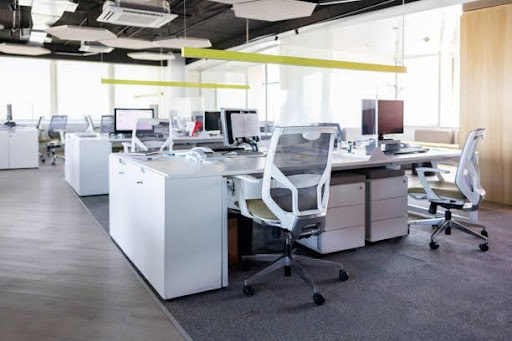In the landscape of modern work environments, the office cubicle stands as an iconic symbol. Often portrayed in popular culture as both a symbol of conformity and a bastion of productivity, the cubicle has a storied history that reflects the changing dynamics of the workplace. From its inception as a solution to spatial challenges to its evolution in response to shifting organizational cultures and employee needs, the office cubicle has undergone significant transformations over the years.
The Birth of the Cubicle
The concept of the cubicle can be traced back to the 1960s when office design began to shift from large, open floor plans to more segmented spaces. As companies grew and the workforce expanded, the need for efficient space utilization became increasingly apparent. Robert Propst, an American designer working for the furniture company Herman Miller, is often credited with developing the first modern cubicle system in the early 1960s.
Proust’s vision was to create a flexible and adaptable workspace that offered employees both privacy and collaboration opportunities. His design, known as the Action Office, consisted of modular components that could be arranged in various configurations to suit different needs. It featured low partitions to define individual work areas while still allowing for interaction with colleagues.
Rise to Prominence
Despite its innovative design, the early reception of the cubicle was mixed. While some saw it as a welcome alternative to the traditional office layout, others criticized it for its perceived lack of aesthetic appeal and stifling effect on creativity. However, as the cost-effectiveness and practicality of cubicles became evident, they gained widespread acceptance across industries.
Throughout the 1970s and 1980s, the cubicle proliferated in offices around the world. Its modular design and ability to maximize space made it an attractive option for businesses looking to accommodate growing staff numbers without expanding their physical footprint. Additionally, advancements in technology, such as the introduction of personal computers, further fueled the adoption of cubicles by providing employees with the tools they needed to work independently.
The Cubicle Culture
By the 1990s, the cubicle had become synonymous with corporate culture. It was not only a physical space but also a symbol of hierarchy and organizational structure. Executives occupied larger, more luxurious cubicles with corner views, while entry-level employees often found themselves in smaller, more cramped quarters.
The layout of cubicle farms, where rows upon rows of identical workstations were arranged in grid-like patterns, became a common sight in office buildings. While this layout maximized space efficiency, it also contributed to the perception of the cubicle as a soulless and monotonous environment.
Criticism and Backlash
As the cubicle became more prevalent, it also attracted criticism from both employees and designers. Critics argued that the lack of privacy and personal space inherent in cubicle layouts could lead to decreased morale, reduced productivity, and a sense of isolation among workers.
Moreover, studies began to emerge suggesting a link between prolonged exposure to the cramped confines of a cubicle and various health issues, including musculoskeletal problems and increased stress levels. Critics also lamented the impact of cubicles on workplace culture, citing concerns about communication barriers and the erosion of creativity and collaboration.
The Shift towards Open Offices
In response to these criticisms, many organizations began to rethink their approach to office design. The early 21st century witnessed a resurgence of interest in open office layouts, which eschewed cubicles in favor of expansive, partitioned spaces designed to foster collaboration and communication.
Advocates of open offices touted their ability to break down barriers between employees, encourage spontaneous interactions, and promote a sense of camaraderie among team members. Additionally, open layouts were praised for their flexibility, allowing for easy reconfiguration as organizational needs evolved.
The Hybrid Approach
Despite the popularity of open offices, the pendulum has begun to swing back towards a more balanced approach to workplace design. Recognizing that one size does not fit all, many companies have embraced a hybrid model that combines elements of both open and enclosed spaces.
This hybrid approach acknowledges the importance of privacy and focused work while still emphasizing collaboration and teamwork. It may involve incorporating a mix of private offices, semi-private workstations, and communal areas into the office layout to accommodate the diverse needs of employees.
Reimagining the Cubicle
In recent years, there has been a renewed interest in reimagining the cubicle for the modern workplace. Designers and architects are exploring innovative solutions that aim to address the shortcomings of traditional cubicle layouts while retaining their practicality and efficiency.
One emerging trend is the concept of the “neighborhood” or “activity-based” workstation, which offers employees a variety of settings tailored to different tasks and work styles. For example, a single workstation may include a standing desk for focused work, a cozy lounge area for informal meetings, and a soundproof pod for private conversations.
Conclusion
The office cubicle has come a long way since its inception, evolving in response to changing organizational dynamics and employee preferences. While it has faced its fair share of criticism over the years, the cubicle remains a ubiquitous feature of modern workplaces.
As we look to the future, the challenge lies in striking the right balance between privacy and collaboration, individual focus and collective creativity. By embracing flexible design principles and incorporating the latest innovations in workplace technology, the cubicle of tomorrow has the potential to be a truly transformative space that enhances productivity, fosters engagement, and supports the well-being of employees.

